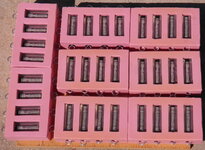GregMuller
Member
In reading through the posts a number of people useing PR use some form of vibration to help with the bubbles. My first question is does it really work and the second question is how and at what point in the process do you do it. I am useing PR from casting craft and useing the resin saver molds. I have had decent sucess but have had some failure due to brittle blanks and bubbles. I do warm my resin before mixing and pouring and I have no plans on investing in a pressure pot. Time is not an issue for me as I have plenty of time for curing. So where in the process do you vibrate, what do you use to do it and for how long? Thanks.

